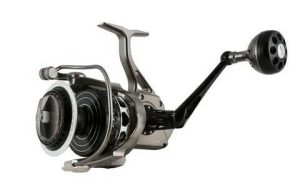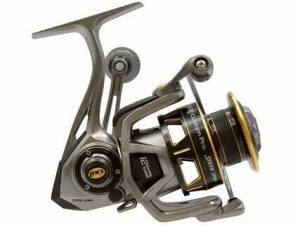A spinning fishing reel is a type of fishing tackle that is designed to be used with spinning rods. It is a popular type of reel because of its versatility, ease of use, and ability to handle a wide range of fish species and fishing conditions.
Spinning reels have a spool that is fixed in place and rotates around a central axis when the handle is turned. This rotation creates a drag system that allows the angler to control the tension on the fishing line and prevent it from being pulled too hard by a fish.
When choosing a spinning reel, there are several factors to consider, including the size of the reel, the type of fishing line it can handle, the gear ratio, and the drag system. The size of the reel should be matched to the size of the fishing rod and the species of fish being targeted. The fishing line should be compatible with the reel’s line capacity and the fishing conditions.
The gear ratio of the reel determines how quickly the spool rotates, which affects the speed at which the line is retrieved. A higher gear ratio means a faster retrieval, which can be useful for certain types of fishing.
The drag system is an important feature of a spinning reel because it allows the angler to control the tension on the fishing line when fighting a fish. A good drag system should be smooth and reliable, and allow for easy adjustments to the tension.
Overall, a spinning fishing reel is an essential piece of tackle for any angler who wants to enjoy a versatile and effective fishing experience.
Choosing a spinning reel
When choosing a spinning reel, there are several factors to consider. Here are some important things to keep in mind:
- Size: The size of the reel should match the size of the fishing rod you plan to use. Look for a reel that is labeled with a line weight and rod length that matches your rod. A heavier rod will require a larger reel, while a lighter rod can use a smaller one.
- Material: Spinning reels can be made of various materials, such as aluminum, graphite, or a combination of both. Aluminum reels are more durable and heavier, while graphite reels are lighter and more affordable. Consider your budget and fishing needs when choosing the material.
- Bearings: The number and quality of bearings can affect the smoothness and performance of a spinning reel. Look for a reel with at least four or five high-quality bearings.
- Gear Ratio: The gear ratio determines how quickly the spool rotates and how fast the line is retrieved. A higher gear ratio means a faster retrieval, but it can also make it more difficult to control the fish. Consider the type of fishing you will be doing to determine the appropriate gear ratio.
- Drag System: A good drag system is important for controlling the tension on the line when fighting a fish. Look for a reel with a smooth and reliable drag system that can be easily adjusted.
- Line Capacity: The line capacity of a reel determines how much fishing line it can hold. Consider the type of fishing you will be doing and the size of the fish you will be targeting to determine the appropriate line capacity.
Overall, when choosing a spinning reel, it’s important to consider your fishing needs and budget to find the best.
Size:
When choosing a spinning reel, it’s important to consider the size of the reel in relation to the size of the fishing rod you will be using. A general rule of thumb is to match the reel size with the rod size, but there are a few other factors to consider as well.
The size of the reel is typically indicated by a number or a series of numbers, such as “2000” or “4000”. The higher the number, the larger the reel. However, different manufacturers may use different numbering systems, so it’s important to look at the reel’s line capacity and weight as well.
For example, if you have a 6 to 7-foot rod rated for 6 to 12-pound test line, you will want to look for a spinning reel in the 1000 to 2500 size range. If you have a heavier rod rated for 12 to 20-pound test line, you may want to look for a reel in the 3000 to 4000 size range.
Keep in mind that the size of the reel can also affect its weight and balance. A larger reel may be heavier and make the rod feel top-heavy, while a smaller reel may not hold enough line for your needs. It’s important to find the right balance between the rod and reel for optimal performance and comfort.

Material:
When choosing a spinning reel, the material it is made https://www.buydo.eu of is an important consideration. The two main materials used in spinning reels are aluminum and graphite, although some reels may use a combination of both.
Aluminum spinning reels are known for their durability and strength. They are resistant to corrosion and can withstand heavy use and abuse. However, aluminum reels are generally heavier and more expensive than graphite reels.
Graphite spinning reels, on the other hand, are known for their lightweight and affordability. They are easier to handle for long periods of time and can be a good choice for beginners or anglers who fish less frequently. However, graphite reels may not be as durable as aluminum reels and may be more prone to damage from impact.
Some spinning reels may use a combination of both materials, with the body and rotor made of aluminum and the spool made of graphite. This can offer a good balance between strength and weight, although these reels may be more expensive than all-graphite models.
Ultimately, the choice of material will depend on your budget, fishing needs, and personal preferences. If you plan on fishing in saltwater, where corrosion can be a problem, an aluminum reel may be the better choice. If you plan on doing a lot of casting and retrieving, a lightweight graphite reel may be more comfortable to use.
Bearings:
When choosing a spinning reel, the number and quality of bearings is an important factor to consider. Bearings are used to reduce friction and ensure smooth operation of the reel, and more bearings generally mean smoother performance. However, the quality of the bearings is also important, as poorly-made bearings may wear out quickly or not provide as much smoothness as high-quality bearings.
A good spinning reel should have at least four or five high-quality bearings. Higher-end reels may have seven or more bearings, which can provide even smoother operation. It’s important to note that some reels may have more bearings but may not be of high quality, so it’s important to look for reels with high-quality bearings.
Another factor to consider is the type of bearing. Stainless steel bearings are the most common and are durable and resistant to corrosion. Ceramic bearings are also available and can offer even smoother performance, although they are generally more expensive than stainless steel bearings.
When selecting a spinning reel, it’s important to choose one with a sufficient number of high-quality bearings to ensure smooth operation and longevity.
Gear Ratio:
When choosing a spinning reel, the gear ratio is an important consideration. The gear ratio determines how many times the spool rotates with each turn of the handle, and it can affect how quickly you can retrieve your line and how much control you have over the fish.
A high gear ratio means that the spool rotates more times with each turn of the handle, resulting in faster line retrieval. This can be useful when fishing in open water or when trying to quickly bring in a fish. However, a high gear ratio can also make it more difficult to control the fish, particularly if it’s a larger one. A lower gear ratio means that the spool rotates fewer times with each turn of the handle, resulting in slower line retrieval but more power and control when fighting a fish.
The gear ratio is usually indicated by a set of numbers, such as 5.2:1 or 6.2:1. The first number represents the number of times the spool rotates with each turn of the handle, while the second number represents the number of times the handle must be turned to complete one full rotation of the spool.
When selecting a spinning reel, consider the type of fishing you will be doing and choose a gear ratio that is appropriate for your needs. If you plan on fishing for larger or more powerful fish, a lower gear ratio may be more appropriate, while a higher gear ratio may be more suitable for fishing in open water or for quickly retrieving your line.
Drag System:
When choosing a spinning reel, the drag system is an important consideration. The drag system helps to control the amount of resistance a fish feels when it pulls on the line, and it can be an essential component when fighting larger or more powerful fish.
There are two main types of drag systems: front drag and rear drag. Front drag systems are typically located on the front of the reel, while rear drag systems are located on the rear of the reel. Front drag systems tend to be more powerful and offer more control over the fish, while rear drag systems are typically easier to adjust while fighting a fish.
Drag systems are typically made up of a stack of washers that apply pressure to the spool to control the amount of resistance. The number and quality of the washers can affect the smoothness and durability of the drag system. High-end spinning reels may use carbon fiber or other high-quality materials for the washers, which can provide smoother operation and greater durability.
When selecting a spinning reel, consider the type of fish you will be targeting and choose a reel with a drag system that is appropriate for your needs. If you plan on fishing for larger or more powerful fish, a front drag system may be more appropriate, while a rear drag system may be more suitable for smaller fish or for beginners who need easier adjustability. Additionally, look for reels with high-quality washers to ensure a smooth and reliable drag system.
Line Capacity:
When choosing a spinning reel, line capacity is an important consideration. The line capacity refers to the amount of fishing line that the spool can hold, and it’s important to choose a reel with a capacity that is appropriate for the type of fishing you plan to do.
The line capacity of a spinning reel is usually indicated in terms of the maximum line weight and length that the spool can hold. For example, a reel may have a line capacity of 8 pounds/200 yards, which means it can hold up to 200 yards of 8-pound test fishing line.
When selecting a spinning reel, consider the type of fishing you will be doing and choose a reel with a line capacity that is appropriate for your needs. If you plan on fishing in open water or for larger fish, you may need a reel with a higher line capacity. If you plan on fishing in smaller streams or for smaller fish, a reel with a lower line capacity may be sufficient.
It’s also important to consider the type of fishing line you plan to use, as different types of line may require different spool capacities. For example, braided line may require a larger spool capacity than monofilament line of the same weight.
Overall, choosing a spinning reel with an appropriate line capacity can help ensure that you have enough line to successfully land your catch without worrying about running out of line.
